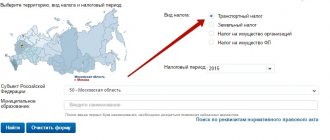What is transport tax?
Transport tax is a tax levied on vehicle owners. Transport means are: cars, motorcycles, scooters, buses, airplanes, helicopters, motor ships, yachts, sailing ships, boats, snowmobiles, motor sleighs, jet skis, motor boats and other water and air vehicles.
Not all vehicles are subject to taxation. For example, the following exceptions exist: - rowing boats, as well as motor boats with an engine power of no more than 5 horsepower - vehicles that are wanted, subject to confirmation of the fact of their theft (theft) by a document issued by an authorized body. The full list of exceptions is indicated in Article 358 of the Tax Code of the Russian Federation.
Payers of transport tax are both individuals and legal entities.
Calculation of transport tax in 2021
Tax must be paid only for those months when the vehicle was registered to the taxpayer. In this case, the calculation is carried out monthly and in full months, while registration can take place on any day. In this regard, the following rules have been established.
If the car is registered from the 1st to the 15th day of the month inclusive, then this month is taken as a full month. And if registration took place between the 16th and the last day of the month, then this month is not taken into account when calculating the tax.
When registration is terminated, the situation is reversed. If a car is deregistered from the 1st to the 15th of the month inclusive, then no tax is paid for that month. And if the date of deregistration falls on the period from the 16th to the last day of the month, then the tax will have to be paid for the full month (clause 3 of Article 362 of the Tax Code of the Russian Federation).
Regional laws for organizations may establish advance payments. In this case, at the end of each reporting period (first, second and third quarters), an amount equal to ¼ of the product of the tax base and the tax rate, taking into account the increasing coefficient (clause 2.1 of Article 362 of the Tax Code of the Russian Federation), is paid.
An example of calculating transport tax in 2021
The organization owns two cars. Truck with engine power 300 hp. s., which was purchased and registered on March 16, 2021. And a passenger car with an engine power of 205 hp. s, which was purchased in the previous tax period. This machine is included in the list of expensive ones (cost from 3 million to 5 million inclusive).
Based on regional law, the tax rate for a truck is 100 rubles/hp, and for a passenger car - 50 rubles/hp. With. The tax base is the engine power in horsepower. Regional law establishes advance tax payments.
Let's calculate the tax on a truck.
Since the car was purchased in mid-2021, you need to determine the number of months for which tax is paid. Since the registration date falls on the 16th day of the month, this means that the month of registration (March) is not taken into account when calculating the tax. And in January and February the organization did not have a car.
Thus, for the first quarter the amount of the advance payment is not formed, since the ownership coefficient (Q) for this period will be 0/3, that is, it will be equal to zero. For the second and third quarters you will need to pay 7,500 rubles (1/4 × 300 hp × 100 rubles/hp). And you will have to pay the same amount at the end of the year, since the annual Kv will be 9/12 or 0.75. (300 hp × 100 rub./hp × 0.75 – 7,500 rub. × 2) = 7,500 rub.
Let's calculate the tax on a passenger car.
Kv will always be equal to one, since the car was in the possession of the company throughout 2020. An “expensive” coefficient of 1.1 must be additionally applied to the amount of tax and advance payment.
It turns out that for each quarter the organization will pay 2,819 rubles. Here's the calculation: 1/4 × 205 hp. × 50 rub./hp × 1.1 = 2,818.75 rub.; According to the rules of paragraph 6 of Article of the Tax Code of the Russian Federation, this amount is rounded up to the full ruble. The tax at the end of the year will be 11,275 rubles (205 hp × 50 rubles/hp × 1.1). Therefore, you will have to pay an additional 2,818 rubles (11,275 rubles – 2,819 rubles × 3).
In total, for two cars the organization must pay:
- for the first quarter - 2,819 rubles (0 + 2,819).
- for the second quarter - 10,319 rubles (7,500 + 2,819)
- for the third quarter - 10,319 rubles (7,500 + 2,819)
- at the end of the year - 10,318 rubles. (7,500 + 2,818).
The total amount of transport tax for 2021 will be 33,775 rubles (22,500 rubles + 11,275 rubles).
How to calculate the tax amount?
The amount of transport tax is calculated based on the following parameters: — Tax rate
The tax rate is established by the laws of the constituent entities of the Russian Federation per one horsepower of engine power.
Depends on power, gross capacity, vehicle category and year of manufacture of the vehicle. Tax rates can be increased or decreased by the laws of the constituent entities of the Russian Federation by no more than 10 times the rate specified in the Tax Code of the Russian Federation. — Tax base
This parameter is set depending on the type of vehicle.
For cars, motorcycles and other vehicles with an engine, this is the engine power in horsepower - Ownership period
The number of complete months of ownership of the vehicle during the year.
— Increasing coefficient
For passenger cars with an average cost of 3 million rubles. a multiplying factor is applied. The list of such cars is available on the website of the Ministry of Industry and Trade of the Russian Federation.
Taxation procedure
There have been no significant changes in the procedure for calculating the amount of transport tax this year. As in the previous period, the car tax based on engine power will have the following indicators:
- passenger car - from 15 to 300 rubles per 1 hp;
- bus - from 5 to 25 rubles per 1 hp;
- motorcycle - from 5 to 25 rubles per 1 hp;
- cargo vehicle – up to 8.5 rubles per 1 hp.
If the car is of low power, then you will have to pay a minimum tax for it, and for very high engine power, special tariff plans are applied.
Since the transport tax is regional, each subject of the state has the right to make additional amendments if the amount of the tax is several times higher than the permitted figure.
Who is entitled to transport tax benefits?
At the federal level, the following categories of citizens are exempt from paying transport tax:
- Heroes of the Soviet Union, heroes of the Russian Federation, citizens awarded Orders of Glory of three degrees - for one vehicle;
- veterans of the Great Patriotic War, disabled people of the Great Patriotic War - for one vehicle;
- combat veterans, disabled combat veterans - for one vehicle;
- disabled people of groups I and II - for one vehicle;
- former minor prisoners of concentration camps, ghettos, and other places of forced detention created by the Nazis and their allies during the Second World War - for one vehicle;
- one of the parents (adoptive parents), guardian, trustee of a disabled child - for one vehicle;
- owners of passenger cars with an engine power of up to 70 horsepower (up to 51.49 kilowatts) inclusive - for one such vehicle;
- one of the parents (adoptive parents) in a large family - for one vehicle;
- owners of vehicles belonging to other preferential categories.
In addition to the federal list of preferential categories of citizens, there are regional benefits. For example, in some regions of the Russian Federation, pensioners pay only 50% of transport tax, or are completely exempt from it. The situation varies greatly depending on the region. For example, in Moscow there are no benefits for pensioners, and in St. Petersburg pensioners are completely exempt from paying transport tax for a domestically produced car with an engine power of up to 150 horsepower.
You can find out the availability of regional benefits on the tax service website, in the “electronic services” section. On this page you must select a subject of the Russian Federation, municipality (city), type of tax and year. After this, you will receive complete information about all types of transport tax benefits for individuals.
It is important to know that the tax authority does not have the right to provide a transport tax benefit based solely on age information. Benefits are of a declarative nature, as a result of which it is necessary to submit to the Federal Tax Service the taxpayer’s application in the prescribed form, which indicates the basis for providing the benefit (reaching retirement age).
Increasing coefficients for calculating transport tax
The tax on expensive cars is calculated taking into account the increasing coefficient (clause 2 of Article 362 of the Tax Code of the Russian Federation). It amounts to:
- 1.1 - for passenger cars worth from 3 million to 5 million rubles. inclusive, from the year of manufacture of which no more than 3 years have passed;
- 2 - for passenger cars worth from 5 million to 10 million rubles. inclusive, from the year of manufacture of which no more than 5 years have passed;
- 3 - for passenger cars worth from 10 million to 15 million rubles. inclusive, from the year of manufacture of which no more than 10 years have passed, as well as in relation to passenger cars costing from 15 million rubles, from the year of manufacture of which no more than 20 years have passed.
The list of such cars for 2021 is posted on the website of the Ministry of Industry and Trade. When using this list, please note that some of them have additional restrictions. We are talking about the column “Number of years that have passed since the year of issue” of the table. For example, for BMW M240i xDrive cars with a 2,998 cc petrol engine. see coefficient applies only if 1 to 2 years inclusive have passed from the date of issue.
How to determine the number of years that have passed since the car was manufactured? The Tax Code of the Russian Federation does not contain clear explanations in this regard. In practice, two approaches to calculating the age of cars have been developed.
The first is based on the explanations given in the letter of the Federal Tax Service dated 03/02/15 No. BS-4-11 / [email protected] It says that when calculating the transport tax for 2014 in relation to a 2011 car, the number of years that have passed since the year of its manufacture, is 4 years. That is, the number of years that have elapsed since the year of manufacture of the car is determined in whole years. Therefore, the age of a car just released by a factory is one year (for the period before the end of the calendar year in which it was manufactured).
This means that the transport tax for 2021 for an expensive car in 2021 must be calculated taking into account the fact that the number of years that have passed since the year of its manufacture is 1 year. Such a car falls into the category “from 1 to 2 years inclusive” as defined in the list. Therefore, you will have to apply a multiplying factor.
The second approach is also based on official explanations. The letter of the Ministry of Finance dated 06.11.14 No. 03-05-04-01/28303 (brought to the attention of the tax authorities by the Federal Tax Service letter dated 07.07.14 No. BS-4-11 / [email protected] ) states that when calculating transport tax for 2014 year for a 2014 car, the number of years that have passed since the year of its manufacture will be no more than 1 year.
It turns out that for a 2021 car, the number of years that have passed since the year of its manufacture will be no more than 1 year. Consequently, such a car does not fall into the “from 1 to 2 years inclusive” category defined in the list, and when calculating the tax for 2021, an increasing factor is not required.
Unfortunately, there is no arbitration practice on this issue. Therefore, the taxpayer will have to decide for himself which of the above approaches to apply when calculating the age of the car. You can also contact the tax authority at the place of registration with a written request about the procedure for calculating transport tax in relation to a specific car (subclause 1, clause 1, article of the Tax Code of the Russian Federation). Following this clarification will exempt you from tax liability and will become the basis for non-accrual of penalties (subclause 3, clause 1, article 111 and clause 8, article of the Tax Code of the Russian Federation).
Receive requirements and send requests to the Federal Tax Service via the Internet for free
How to calculate the number of complete months of car ownership?
If a vehicle is delivered or deregistered during the year, then the transport tax is calculated with a certain coefficient. This coefficient is defined as the ratio of the number of complete months during which a given vehicle was registered to the number of calendar months in a year (12).
The procedure for determining the number of full months of car ownership is calculated in accordance with paragraph 3 of Art. 362 of the Tax Code of the Russian Federation. Month of registration
It is considered complete if the vehicle
is registered
before the 15th day inclusive.
The month of deregistration is considered complete if the car is deregistered
after the 15th day. For example, if a car was registered after the 15th, then this month is not complete and is not taken into account when calculating the car tax.
Rules and deadlines for paying taxes for individuals
Residents of the Moscow region may not calculate the tax amount themselves. It is enough to wait for the tax notification from the Federal Tax Service. This document represents a breakdown of charges for each vehicle owned by the payer in the past year.
You can check the correctness of the specified information using the multiplication formula with the same factors that were listed for legal entities.
The tax payment deadline for citizens is December 1. If funds are not credited on time, penalties will be charged on the entire amount daily.
Deadline for payment of transport tax for individuals in 2021:
- for 2021 - no later than December 1, 2021
- for 2021 - no later than December 1, 2022
Please take into account: in accordance with paragraph 7 of Art. 6.1. Tax Code of the Russian Federation, if the last day of the period falls on a weekend, then the day of expiration of the period is considered to be the next working day following it.
Intra-annual payments: how to determine the amount
A mention in regional regulations of the need to make advance payments for transport tax will require:
- calculating their amount;
- timely submission to the budget (within the deadlines established by regional regulations);
- reduction at the end of the year in the amount of tax on advances paid.
Advance payments are calculated as follows:
We'll show you how to calculate advances and taxes for a car for the year using an example.
Using practical examples from our website, you can quickly master the techniques of tax and other calculations:
- “Calculation of VAT when importing goods - an example”;
- “Accrual of sick leave - an example”;
- "Calculating the number of vacation days - an example."








